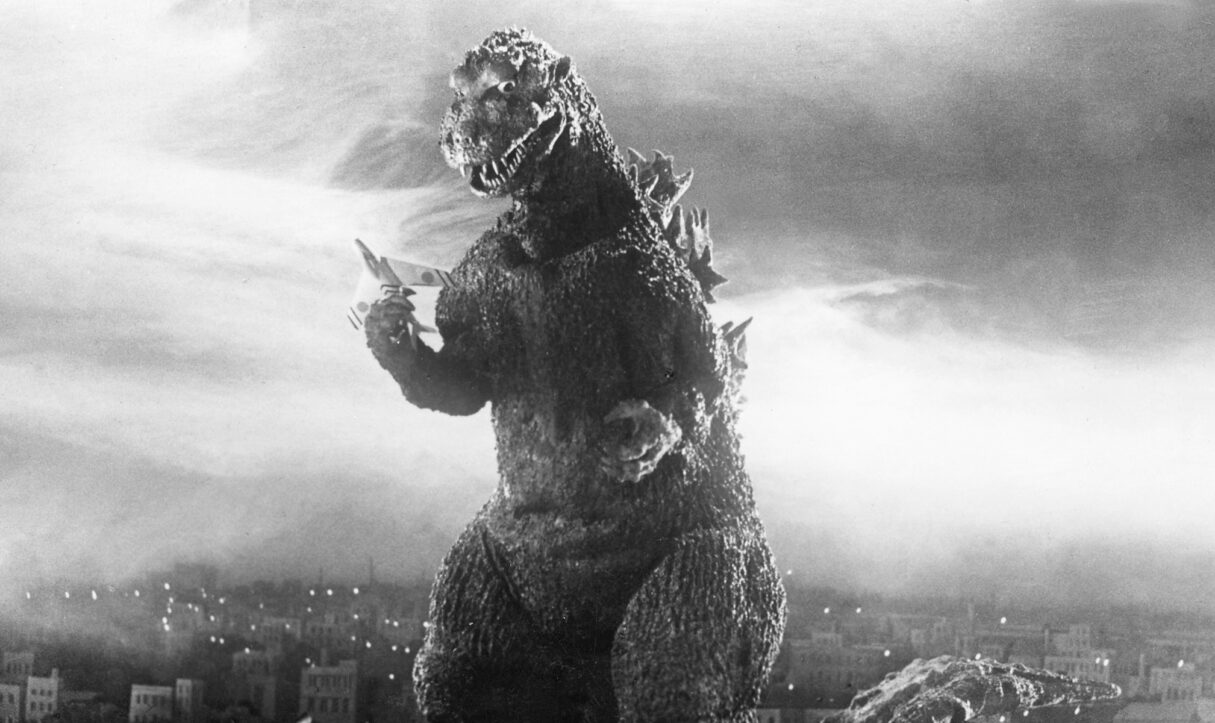A gigantic dinosaur-like monster landed on the soil of Tokyo with roaring footsteps. The monster moved step by step toward the center of Tokyo, destroying numerous buildings and people’s lives along the way. Godzilla launched an incandescent laser at the city center, which caused an excessive blast, then a massive mushroom cloud, and then radioactive black rain began to fall.
Don’t worry — I’m describing a scene from“Godzilla Minus One,” a 2023 film, recently released in Japan. Seventy years after the original Godzilla movie, “Gojira,” which came out in 1954, Godzilla Minus One is the 38th film remake of the topic, all of which offer a not-too-veiled commentary on the ongoing threats of nuclear weapons.
An Evolving Threat
Godzilla, or Gojira, is a giant lizard with inflamed skin and incandescent radioactive laser power, both gained through nuclear exposure. Armed with such dreadful powers, Godzilla emerges from the ocean, threatening Japanese citizens and destroying civilization.
A hydrogen bomb test at Bikini Atoll in 1954, which contaminated the Japanese fishing boat Lucky Dragon Five, inspired the Japanese film production company, Toho Co., Ltd, to create the first “Gojira” movie. The 1954 version painted Gojira as a victim of nuclear weapons suffering from the devastating impact of nuclear testing — the giant lizard’s burnt skin was an allegory for the aftereffects of atomic contamination.
In the original “Gojira,” the monster’s gigantic face first appeared on the screen approximately 30 minutes from the beginning, allowing the mystery enshrouding it to build before unveiling its horrific presence. On the other hand, in “Godzilla Minus One,” Godzilla appears at the very beginning of the movie and demonstrates its devastating strength as if to emphasize the precarity and imminence of the nuclear threat. Later, Godzilla arrives in Tokyo and the shape of his destruction — the mushroom cloud, the radioactive rays — directly references the impacts of nuclear weapons.
“Gojira” and “Godzilla” both are reminders of a tragic history that continues to threaten to repeat itself. In the conclusion of the original movie, when Gojira was defeated, Dr. Kyohei Yamane, a paleontologist character, warned of the threat of more devastation as long as nuclear testing is repeated. “But, if we keep on conducting nuclear tests, it’s possible that another Gojira might appear somewhere in the world, again,” Yemane cautions.
In “Godzilla Minus One,” when the monster is defeated, there is no clear statement like that of Yamane indicating such a horrific possibility. Instead, the threat comes in a visual form: Godzilla’s remaining cells in the ocean keep dividing and growing to show the possibility that a threat of mass destruction still exists.
The shift in the film’s conclusions fits the historical shifts between their release dates. While “Gojira” memorialized nuclear attacks that felt like armageddon — single catastrophes that threatened to end us all, in the decades since, the world’s nuclear arsenal has continued to grow exponentially, and the threats of nuclear proliferation are deeply entrenched. Today’s version of the film thus echoes this endless proliferation, with Godzilla’s cells continuing to multiply underground.
“Godzilla Minus One” also illustrated the power of civil society. In the film, due to the US occupation, the Japanese government was not able to combat Godzilla. Instead, it was veterans of WWII who stood together to fight to eliminate Godzilla. This references the activation of Japanese civil society to advocate to end nuclear testing and abolish nuclear weapons. Such a movement eventually became a core impetus in the global nuclear disarmament movement. As the fictional Godzilla is defeated by the civilian collaborative project of eliminating the monster, we are reminded of the real life resilience and potential of civil society.
Human Wisdom
Despite the technological evolution both in the production of the film and in the final product, the path forward remains the same: it is human wisdom and critical thinking that can save us from ourselves.
In the original “Gojira,” the threat was ultimately eliminated by a cutting-edge scientific technology called Oxygen Destroyer. The fictional scientist, Dr. Daisuke Serizawa developed the devastating weapon, more powerful than a hydrogen bomb. In the new film, a scientific theory again tries to remove the threat of Godzilla. Dr. Kenji Noda, a former Naval weapons engineer, decided to try to use Freon gas to drag Godzilla deep into the ocean where extraordinary underwater pressure could crush the monster. In both cases, it is human ingenuity that prevails against the devastating threat to mankind.
The year 2024 marks the 70th anniversary of the creation of the 1954 “Gojira” movie. It is also the 79th anniversary of the use of nuclear weapons in Hiroshima and Nagasaki. There is a growing sense of urgency to achieve the goal of a world without nuclear weapons. And Russia’s ongoing aggression against Ukraine vividly reminds us of the threat of the possible use of nuclear weapons.
While paying tribute to the original “Gojira,” “Godzilla Minus One” is once again warning us of the ongoing threat that should not be repeated. As the movie illustrated, the onus is on us.
Note: The views and opinions expressed in this research are purely those of the author and do not represent any institution or organization she is associated with.





















